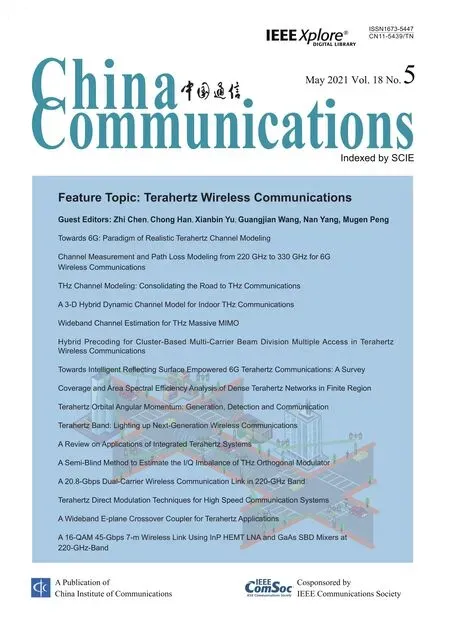A Review on Applications of Integrated Terahertz Systems
Xuyang Lu,Suresh Venkatesh,Hooman Saeidi
1 University of Michigan-Shanghai Jiao Tong University Joint Institute,Shanghai Jiao Tong University,Shanghai 200240,China
2 Department of Electrical and Computer Engineering,Princeton University,Princeton,NJ 08540,USA
Abstract:A review on Terahertz end-to-end systems with an emphasis on integrated approaches is presented.Four major catalogs of THz integrated systems,including THz communication systems,THz imaging systems,THz radars,and THz spectroscopy systems,are reviewed in this article.The performance of integrated systems is compared with non-integrated solutions,followed by a discussion on the trend in future research avenues and applications.
Keywords:terahertz;integrated circuit;imaging;communication;spectroscopy;on-chip antenna;CMOS;wireless transceivers;phased array;MIMO
I.INTRODUCTION
Terahertz(THz),a frequency spectrum between the microwave and the optical wavelengths,was historically underdeveloped as compared to the neighboring frequencies due to the challenge of THz signal generation and detection.THz technologies have gradually come to the center of the spotlight a decade ago.Such advances are not only because of the development of THz generation and detection mechanisms but are also driven by the need for various applications,including communication,imaging,and spectroscopy.The upgrades of communication generations from the first generation(1G)to the current fifth-generation(5G)all started with the breakthrough of devices to allow stronger and finer control of the electromagnetic waves,followed by the development of hardware and software to meet the ever-growing need for a highervolume of information exchange.The underdevelopment of THz band applications was due to the scarcity of power generation and sensing devices over this frequency range.In the past decade,new sources including THz monolithic integrated circuits,quantum cascaded lasers(QCLs),photoconductive antennas,have been developed for power generation,and the THz gap is been filled piece by piece through the progress on both sides of the spectrum.
Monolithic integrated circuits,especially CMOS integrated circuits,are among the most popular realizations for THz communication as compared to gas or molecule laser-induced THz generation,microvacuum traveling-wave tube,photomixers,and gyrotrons,not only for the accessibility to be integrated with circuit components for signal generation,retrieving,and processing,but also because of the moderately higher power generation capacity and efficiency,especially for frequencies below 2 THz.
In this review,we will focus on the development on the microwave side towards the lower portion of the THz spectrum,namely from 100 GHz to 2 THz.Within the recent decade,transistor scaling that follows Moore’s law not only provides higher computational power and efficiency in digital signal processing,it also benefits high-frequency power generation with an increased maximum oscillation frequency(fmax).Thefmaxin silicon-germanium(SiGe)bipolar transistors have reached 0.7 THz in 2016,and according to the SiGe HBT roadmap,a realisticfmaxof 2.5 THz can be reached with an additional scaling of transistors by 20%[1].Although the practical useful frequency range is way below thefmaxof a process due to the low efficiency of on-chip passives,low power generation efficiencies,and poor power extraction efficiency out of silicon,afmaxof 2.5 THz is sufficient in supporting most applications,including power generation and detection under 1 THz,where an abundance of THz applications can be investigated[2].The imminent research emphasis in THz integrated circuits is gradually shifting from improving device performance to the development of suitable THz applications that can potentially introduce groundbreaking reformation of everyone’s life[3].The flourish of THz applications will,in turn,promote the researches of THz integrated devices and systems as well.On the other hand,extracting power out of silicon can still be challenging.While power extraction using bond wires is an option,most THz systems use on-chip antenna to achieve higher power extraction efficiency by avoiding the loss and parasitic inductance of bond wires.However,the silicon dielectric bearing high dielectric constant still traps the majority of the THz power.As an example,on an infinite air-silicon interface,the ratio of the power between the air and substrate interface follows[4]:Pair/Psi=(εair/εsi)3/2≈1/40.Since silicon substrate has a finite thickness that is comparable to the wavelength,the effect of different modes excited inside silicon cannot be ignored.Patch antennas are widely used for on-chip radiation.For a patch antenna,the dielectric thickness should not be much smaller thanto preserve enough radiation efficiency.Therefore,in most THz integrated systems,a conductor plate is placed underneath the chip substrate to allow radiation from the broadside,rather than using higher-layer metals as the reference ground plane.Such phenomenon is also observed in light extraction from silicon,and different approaches have been attempted to improve the radiation efficiency,including introducing surface roughness into the air-substrate interface,by the placement of nano-cavities at the interface,and adjusting substrate thickness for radiating mode enhancement[5-7].
While not being the main focus of this review,in addition to the electronic method,the photonic method is another good candidate for generating THz power.QCL-based THz sources can achieve a similar directivity and power level,which makes it another good candidate for implementing integrated THz systems.The power generation capacity of a QCL and a THz CMOS phased array are both limited by the power/current density the devices can sustain.The bottleneck in the MMIC method is the limitation on charge carrier mobility to allow high-frequency oscillation.In the photonics-based THz generation method,the relatively small energy level difference of THz frequencies as compared to optical frequencies makes it difficult to control the discrete energy jumps in a QCL[8].A comprehensive review of integrated photonic THz devices can be found in[9].To achieve higher THz power,monolithic integrated phased arrays are preferred as their power can be combined in free-space in the form of beamforming,which also provides higher tunability as compared to the QCLs.
The rest of the paper is organized as follows:This review will start with the discussion of THz communication with an application-driven perspective.The distinctive features of THz,including wide bandwidth and narrow beamwidth,will be discussed under realistic application scenarios,including satellite communications and secure wireless communications.Practical design considerations and prospective fields of study are discussed in section II.A review of integrated THz imaging systems is presented in section III,with an emphasis on achieving fully electronic coherent detection.Non-coherent detection,coherent detection,and near-field THz detection are presented and compared.Integrated THz radar will be introduced in section IV.Finally,the application of integrated spectroscopy is discussed in section V.The authors conclude the findings and suggest future research trends of integrated THz systems in section VI.
II.THZ INTEGRATED COMMUNICATION SYSTEMS
One of the strongest motivations to move towards THz is to exploit THz as a carrier signal for future wireless communication.As suggested by the Shannon-Hartley theorem

given a specific signal-to-noise ratio(SNR),the channel capacity is limited by the bandwidth that can never exceed the carrier frequency.Therefore,to meet the ever-increasing demand for higher communication capacity and shorter delay,the carrier frequency will inevitably be extended into millimeter-wave(mmWave)and THz frequencies.The next question would be to choose the best frequency of operation for the next generation of communication.The answer to the question can only be a reconciliation of the requirement for communication bandwidth and the hardware limitations,including the transceiver system itself,the peripheral circuit components to process the information,and also the capacity of the batteries.At the lower portion of the THz band,a 47 GHz transmission window exists at a frequency of 300 GHz to be exploited for communication[10,11].
2.1 The Demand for High Bandwidth Communication
In general,wireless communication exploits electronic devices as a transducer between signals that humans can perceive and interpret,such as visual and audio signals,and signals suitable for distanced wireless transmission,such as electromagnetic waves.Since visual representation is the most important form of communication,the data bandwidth required for a majority of applications is essentially limited by the color range and the reaction time human vision receptors bear.The answer to the bandwidth requirement of human visual perception lies in the physiological structure of our eyes.The field of view(FOV)of our eyes is approximately 210°by 100°[12],and more than 60 pixels are required within 1°to avoid the screen door effect.Therefore,12600×6000 pixels are required in an ideal scenario.Furthermore,a millisecond-level delay can be tolerated without introducing significant motion sickness.A 16K resolution(typically 15360×8640)with a refresh rate of 240 Hz is claimed to provide“true immersion in VR”[13].Assuming no codec is used and a 24-bit color depth is used to ensure minimum delay,the corresponding data bandwidth can be calculated as 24×15360×8640×240=764 Gbit/s.A highefficiency video code(HEVC),such as H264,can provide a compression ratio of 250×,thus the bandwidth requirement is on the order of 70 Gbit/s[14].Given a moderate SNR of 25 dB,the bandwidth requirement is approximately 11 GHz for a QAM 64 communication.In addition to immersive VR and Cross Reality(XR)applications that require a combination of resolution,refresh rate,field of view,and motion to photon delay,other potential applications,including holographic communication and digital twins,may require a even higher data bandwidth.In a holographic tele-presence,a real-time 3D video of distant people and objects can be projected while allowing fullmotion real-time interaction.A holographic telepresence of a 77×20 inch human requires a data rate of 4.62 Tbps[15].Unlike immersive VR that primarily focuses on rendering videos to be seen by an individual,holographic telepresence can be viewed by many from different perspectives simultaneously.A digital twin of human takes one step further by replicating and transmitting more subtleties including vital signatures such as body temperature,pulse rate,respiration rate,etc.,using multiple sensors to rebuild all aspects of the target for remote communication,health condition monitoring,diagnosis,and even surgery.Besides projecting human features,an urban digital twin is another example of utilizing a high volume of real-time data to allow sustainable governance of cities by taking real-time economic,ecological,and demographic conditions into considerations[16].More than Tbps of real-time data transmission is desired for such an application.The adoption of THz communication can also play a conducive role in the development of the Internet of Things(IoT)and edge computation[17].Nevertheless,the bandwidth requirements and design considerations for IoTs vary with specific applications,and the discussion is beyond the scope of this review.
2.2 The Necessity of Beamforming in Future Wireless Connectivity
In future wireless communication,phased array beamforming techniques have to be adopted to enhance the directivity in order to compensate for the increased path loss at higher carrier frequencies[18],the path loss increases as we shift toward a higher carrier frequency following the Friis equation:

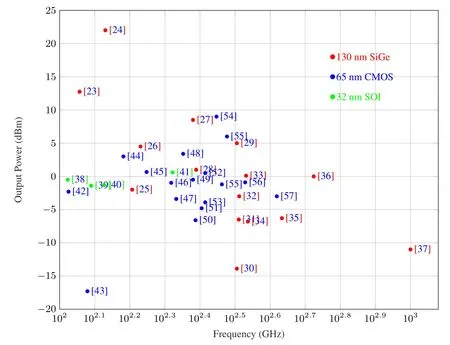
Figure 1.A summary of integrated THz signal generation in three widely-used processes including 65 nm CMOS,32 nm SOI,and 130 nm SiGe.Although 130 nm SiGe shows stronger capability in reaching higher THz frequency due to its higher cutoff frequency.There is no significant advantage of SiGe or SOI as compared with 65 nm CMOS,indicating that a collegial group of weak devices can be exploited for high-frequency power generation.The other observation is that the distribution follows the Johnson limit[58].
wherePris the power received at the receiver,Ptis the transmitted power,DtandDrare the directivities of the transmitting and the receiving antennas,respectively,λis the wavelength of the carrier frequency,αLrepresent a complicated loss coefficient due to rain,gas absorption,and other atmospheric effects,anddis the distance between the transmitter and the receiver.Furthermore,the increased path loss is also contributed by higher water absorption and higher diffraction loss at mmWave and THz wavelengths.Therefore,phased array beamforming is likely to become an indispensable component not only at base stations and backhauls,but also within mobile devices for high-efficiency communication to enhance signal strength.
For immersive VR applications,the path length in a typical indoor model for wireless routers under the current Wi-Fi standard is around 50 meters.More precise modelings of indoor THz communication can be found in[19-21].Assuming a bandwidth of 10 GHz and an SNR of 25 dB to support QAM 64,and a receiver noise figure(NF)of 10 dB[22],the required signal power at the receiver is thus-174+10log(10·109)+25+10=-39 dBm.The path loss for a 300 GHz carrier is 20=-116 dB.
A summary of state-of-the-art THz sources and transmitters is shown in Figure 1.We observe a profusion of works at the 300 GHz window.At this frequency window,typical transmitters can generate a THz power on the order of 5 dBm.To compensate for the severe path loss of THz communication,beamforming methods such as phased array methods have to be adopted so that the output power can be enhanced with larger effective aperture size.Assuming a typical transmitter power of 10 dBm to comply with potential health and interference related regulations,and an equal directivity on the transmitter and the receiver sides,the directivity on both side needs to reach approximately 35 dB to meet the minimum power requirement at the receiver.If a phased array is used,the gain of the array is proportional to the number of elements.Given an array element directivity of 5 dB,the array size is on the order of 200 to 300 elements to allow an indoor THz wireless connection with connectivity similar to today’s WIFI.
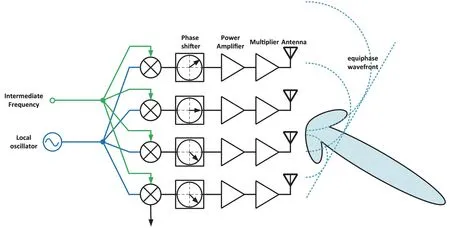
Figure 2.The architecture of a classical THz phased array system.Due to the absence of power amplification at THz frequencies,phase tuning is implemented at mmWave frequencies before frequency multiplying.In a 1-D system,synchronization is guaranteed by the equal delay distribution of the LO signals.
2.3 Design Considerations of THz Integrated Phased Arrays
The architecture of a typical THz superheterodyne transmitting phased array is shown in Figure 2.The base-band signal(BB)contained in the intermediate frequency(IF)is first up-converted to radio frequency(RF)using an active frequency mixer.RF phase shifters are implemented along with variable gain amplifiers to assign proper weights to each array element.Frequency multipliers exploiting the non-linearity of transistors are implemented after RF power amplifiers to generate power in a frequency range where power amplifiers are not available[59-61].The THz power is then radiated out by the antennas that are typically integrated on-chip.The phase of each array element is adjusted so that each element radiates an equiphase wavefront towards the direction of interest where the majority of the power is delivered.The implementation of phased arrays is typically limited by three factors,namely,efficiency,bandwidth,and scalability.The efficiency is primarily limited by the efficiency of THz generation,which is a bottleneck for any THz systems at the moment.In this subsection,the challenges for realizing high bandwidth and scalable array design will be elaborated.
The bandwidth of a phased array is limited not only by the circuit bandwidth to process information and generate wireless power,but also confined by the bandwidth of the radiating elements,typically the antennas,and even the bandwidth limitations related to the array arrangement.although the frequency dispersion problem and spatial under-sampling can be partially mitigated with time-domain beamforming techniques,current phased array systems typically have a bandwidth of 10%-15% of the carrier frequency[62,63,34].Therefore,THz communication with a carrier frequency beyond 100 GHz is one of the most promising candidates for the immersive visual experience to allow seamless remote communication and real-time operations such as remote surgery and holographic communication,based on our estimated bandwidth requirement of 11 GHz in Section 2.1.
Figures 3 and 4 show the output power and data bandwidth of state-of-the-art integrated transceiver systems.It can be observed that,while high data rate and output power can be achieved,most integrated systems have a bandwidth on the order of 10 GHz,which is typically limited by the analog/digital conversion and the digital signal processing units.
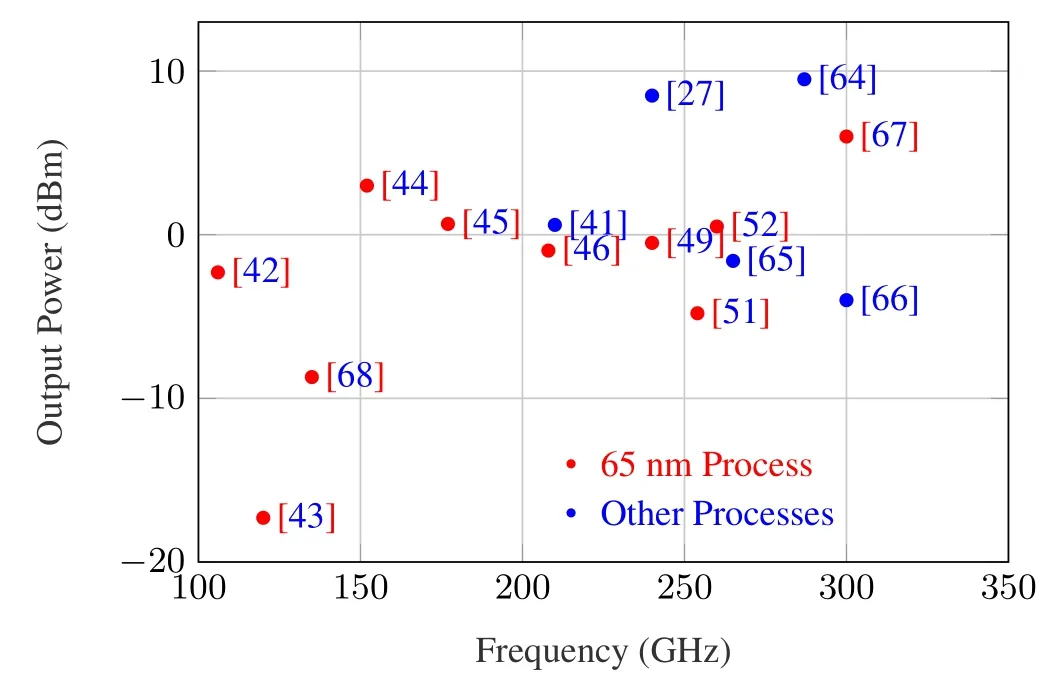
Figure 3.Output power against frequency of transceiver systems in the literature.Note that the output power can be scaled using on-chip power combiner or spatial beamforming with more array elements.
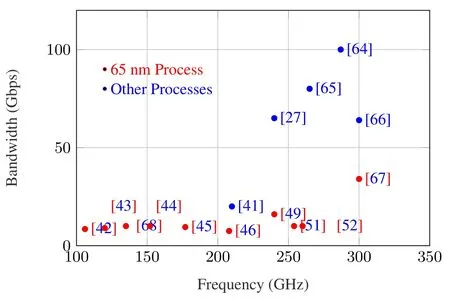
Figure 4.Data bandwidth against the frequency of the transceiver systems reported in the literature.The data bandwidth of a single channel transceiver can be increased by stitching multiple channels together.
The half-power-beamwidth(HPBW)of a phased array follows approximately[69].For a 2D array with 15 elements in each dimension,the beamwidth is approximately 7°.Such a small beamwidth introduces not only challenges in beamforming and alignment,especially for transceiver systems in motion,but also demands spatially distributed backhauls and reconfigurable intelligent reflectors for blockage mitigation[70,71].
Synchronization between radiating elements is one of the biggest challenges in realizing a THz phased array on silicon,especially for 2D arrays.In 1D systems or small-scale 2D THz arrays,a local oscillation(LO)signal is divided and distributed across array elements for synchronization[72,73].As the dimension of the network increases,LO buffers have to be implemented to allow enough power to reach individual radiating pixels for frequency and phase reference.The strictlysymmetrical distribution poses challenges in the distribution of IF signals and phase tuning signals during array scaling,as shown in Figure 5.
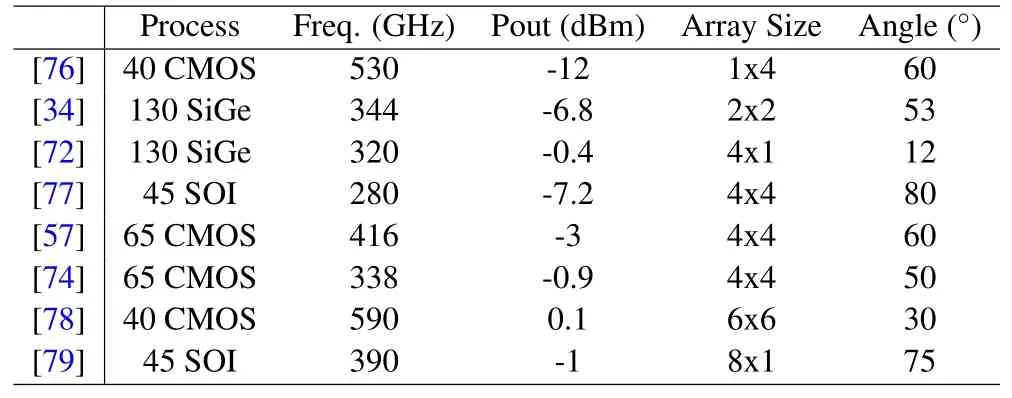
Table 1.State-of-the-art integrated THz phased arrays.
Another class of 2D networks takes advantage of coupled oscillators in a network for LO synchronization[57,74],as shown in Figure 5(b).A coupled oscillators network not only mitigates unwanted coupling between the long LO distribution network and the radiating elements,but also reduce the complexity of LO distribution in large size arrays with a cost of increased circuit complexity,power consumption,while the design of a large 2D individually phase-and-amplitudetunable array is still challenging.A summary of stateof-the-art integrated THz phased array can be found in Table 1.As can be seen,the largest array size in literature is limited to 6×6,which is way smaller than the number of pixels in a CMOS camera or the number of elements in a mmWave phased array[75].Nevertheless,we expect the array size to grow rapidly once more applications in the THz band are developed.
2.4 Perspectives on Future THz Beamformers
The road-map of CMOS cameras may shed light on THz phased arrays.In today’s CMOS camera,stacked topology is adopted to allow high-pixel densities,and to exploit the advantages of different processes in light capturing sensitivity and signal processing capabilities.A similar methodology shall apply to the realization of pixelated mmWave and THz phased array,especially for THz as the spacing between pixels is usually comparable to the dimension of the wavelength.For a 300 GHz array,the spacing for aarray is approximately 500μm,whereas the antenna dimension is on the same order.Nano-fabrication on silicon is a preferable platform to allow the fabrication of circuits and radiating elements at this dimension with enough precision while maintaining a high-yield.

Figure 5.LO distribution methods for large scalable arrays.(a)Conventional architecture with symmetrical LO network.(b)LO distribution by coupled RF oscillators.(c)A stacked THz source for efficient signal processing,THz power generation,THz radiation,and beamforming.

Figure 6.Three beamforming strategies including(a)a transmissive beamformer(b)a reflective beamformer(c)an active beamformer that encompasses power generation and beamforming.
As shown in Figure 5(c),a low-power digital process can be used for baseband signal generation,with a SiGe/III-IV power generation layer at a larger process node stacked on top of the baseband chip.Beamforming can be encoded,either through IF phase shifting with digital beamformers,at the generation layer through RF beam shifters,or at the radiating surface using a reconfigurable metasurface.
Figure 6 outlines three different beamforming strategies including a transmissive type,a reflective type,and an active THz generating surface.Each class has its advantages.As suggested above,both the transmissive and the reflective type supports heterogeneous integration that can take advantage of a stacked topology for efficient power generation.The advantage of a transmissive type beamformer is that a group of beamformers can be implemented in series on the light-path to gradually alter the transmission of EM waves.Such a configuration allows a group of slow and weak modulators to behave collectedly as a fast and strong one by acting as a continuous media.
One drawback of having THz processing,generation,and radiation on the same platform is that,if a substrate is placed underneath the chip,the silicon area underneath the antenna needs to be left empty solely for radiation,which also introduces a higher likelihood of cross-talk between the antennas and the peripheral circuits.Those trade-offs imply that a stacked topology with different layers of integrated circuits specialized for different functionalities may be preferred to optimize the efficiency of power extraction.For instance,a small transistor process node,such as 7 nm CMOS,possesses a compelling advantage in digital signal processing.Nevertheless,the transistor scaling down to a couple of nanometers does not provide higher efficiency in generating THz power.The THz generation capability peaks between 45~65 nm node for CMOS processes and 130 nm for SiGe processes[80].Nevertheless,neither of those two processes are specialized for on-chip antenna design.To enhance the radiation efficiency,a lossless(high-resistivity)substrate with adequate height provides the highest radiation efficiency.The concern of such an implementation is the transmissive loss,both in the beamformer itself and in the dielectric holding the beamformer.The reflective type is typically realized in the form of intelligent reflecting surface(IRS).It serves well as a light-weight solution on the NLoS path for improving the condition of the channel matrix.Although there is a scarcity of IRS in the THz band due to high loss,its potential has been widely recognized in theoretical analysis[81].Finally,most integrated phased arrays shall be characterized into the active beamformer catalog where the power generation and beam-steering are realized within the same planar surface.Evidently,such a planar configuration can be easily integrated into mobile devices,yet the radiating modes and efficiency are also limited by the planar geometry.
A THz meta-surface was implemented as an early attempt for a stacked topology[82].Figure 7 shows the chip photo,unit cell design,material layers stackups,the resulting On-Off ratio,and the field distributions under different switching conditions.This chip consists of a programmable 12×12 meta-element array.Each array element is a tunable split-ring resonator structure with transistors placed at the openings as switches.In order to achieve a better On-Off ratio,a sub-wavelength inductive loop is designed to resonate out a 15-fF parasitic capacitance of the transistors at 300 GHz,which improves the On-Off ratio by 12.5×.The field distribution profiles are shown for different element operating modes that result in distinctive transmission profiles.An array of those elements can collectively demonstrate amplitude and phase control at a subwavelength scale.Such individual CMOS programmable chips are then arranged in a 2×2 array fashion as shown in Figure 8 to form a larger aperture.Figure 9 demonstrates the far-field projection capability of a 24×24 meta-element array.To achieve desired far-field radiation patterns,a genetic algorithm is used to optimize the operating conditions of each element in order to project a letter“P”and a letter“U”at a distance of 5 mm.
The fine control of the electromagnetic field down to a pixel scale can be used to enhance the communication capacity.Zang et al.demonstrated that the color information of an image can be encoded in spatially varying polarization states of light instead of in the amplitude and phase modulation,where a transmissive dielectric metasurface serves as a color mixer by tailoring the polarization of light at the nanometer scale.Such encoding can potentially lead to highdensity data capacity,and higher security in wireless communication[83].
Besides the advantages of a transmissive type beamformer mentioned above,such a metasurface-based beam-steering strategy may offer additional benefits:Firstly,it allows finer sub-wavelength controls of both near-and far-field electromagnetic radiation.Secondly,it reduces circuit complexity by separating power generation and beam-steering.Thirdly,it offers the potential of exploiting distinctive properties of metamaterials,such as non-reciprocity[84]and frequency selectivity[85].The drawback of a metasurface beamformer as compared to the phased array technique,however,is that most metasurface structures rely upon sub-wavelength resonators with narrow bandwidths,and consequently,a wideband metamaterial-based operation can be challenging[86].Furthermore,the loss in the dielectrics in a metasurface inevitably reduces the output power.A reflective type beamformer placed in a spatially distributed fashion can be used as relay backhauls in THz communication to establish an alternative path for communication.In comparison,the active THz beamformers have a low-profile,a small form factor,and is therefore preferred on mobile devices.The future THz wideband communication is very likely to appear in a combination of those three types of beamforming mechanisms.
2.5 Space and Satellite Communication
As shown in Figure 10,in addition to wide bandwidth communication for VR and IoT applications,THz can play an important role in space,air,and satellite communication due to its unique transmission properties.As compared to optical wavelengths,THz beamwidth is wider,and thus allows easier beamforming and capturing.THz is also immune to the background noise of solar radiation that peaks around 0.55μm.The photon energy of THz waves is significantly lower than that of the optical wavelength and is,therefore,more efficient.THz communication can be implemented between satellites for high data-bandwidth star-link,and between satellites,aircraft,and rockets as well.Saeed et al.studied the transmission characteristics of THz over different altitudes using a Line by Line Radioactive Transfer Model(LBLRTM)[87]and conclude that for an altitude of 10 km and above,the useful bandwidth can be as high as 8 THz,owing to decreasing absorption at higher altitude.Furthermore,THz can be a potential solution for establishing communication in the plasma sheath during the re-entry process[88].The re-entry plasma fluid model suggests that a communication frequency of above 0.35 THz will not suffer from a“communication blackout”.When factors including the adequate location of the antenna,vehicle shape,and the chemical reaction rate,are properly chosen,a 120 GHz carrier can be used to maintain normal communication during the re-entry process[89].
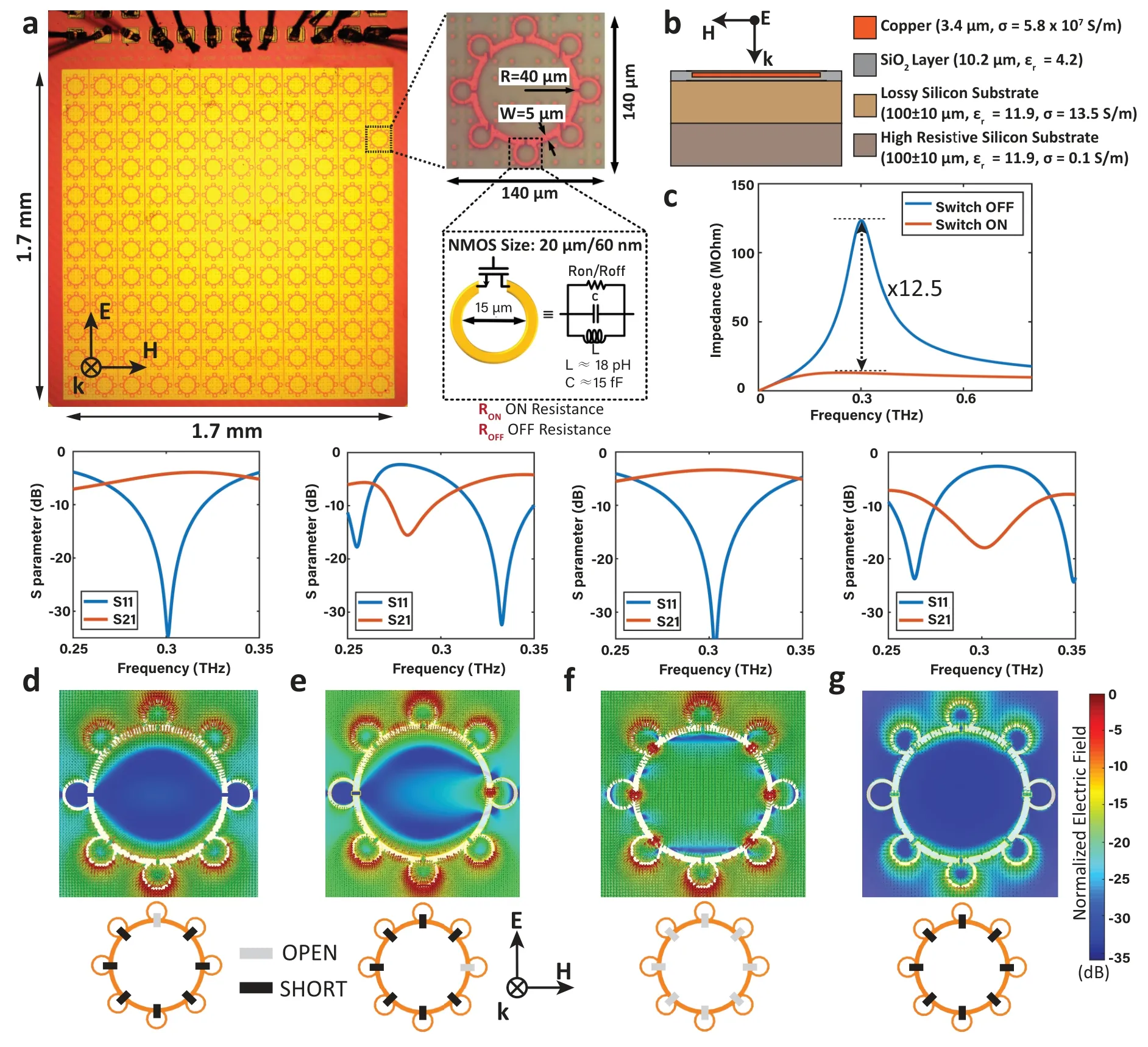
Figure 7.(a)The chip photo of the THz metasurface.(b)The metal and material stack-up used in this design.(c)The On-Off ratio is enhanced through the implementation of micro inductive loops.(d)The field profiles for different modes of operation[82].
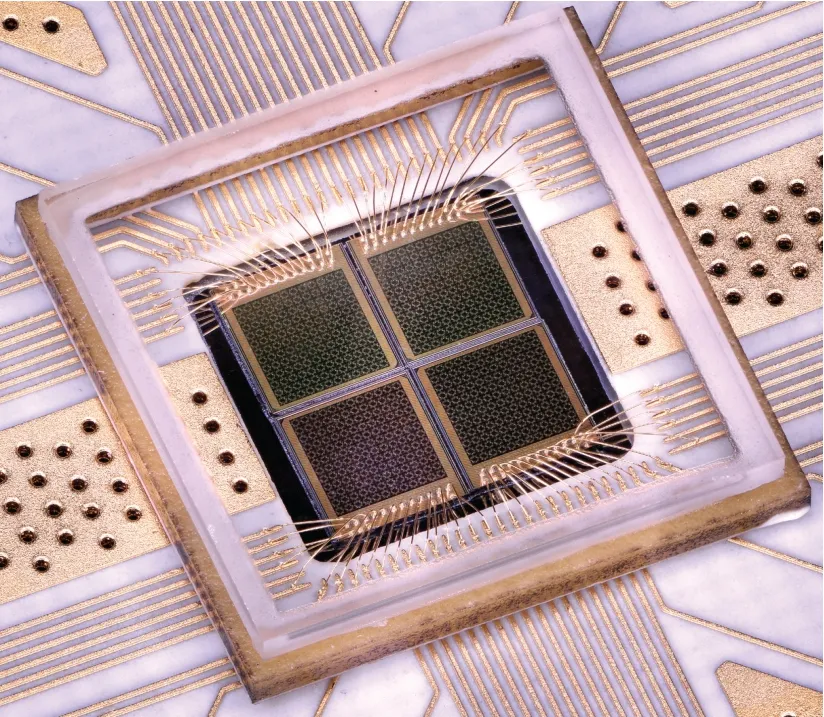
Figure 8.Tiled CMOS metasurface 2×2 chip array forming a larger aperture for arbitrary EM field synthesis,THz beamforming,and spatial light modulation[82].
Promising as the THz space communication could be,one of the biggest challenges in long-range satellite communication using narrow beamwidth THz carrier is the alignment of two highly directive beams.In space and air communication,the relative highspeed motion of the transceivers increases the complexity of beam alignment.Therefore,the accurate direction of arrival(DoA)and direction of departure(DoD)estimation is a key issue in MIMO communication[90-92].Solutions have been proposed not only through the implementation of estimation algorithms such as Multiple Signal Classification(MUSIC)and Estimation of Signal Parameters via Rational Invariance Techniques(ESPRIT),the implementations of customized circuit blocks can also improve the speed and accuracy of alignment significantly[93].The traditional MUSIC algorithm is usually defined upon narrow-band signals,and the DOA is estimated according to the significance of the eigenvectors of the Vandermonde matrix of the steering vectors.Substituting a narrowband signal with a wideband one can significantly improve the condition number of the Vandermonde matrix[94,95].Furthermore,a carefully designed spatial-dependent frequency diverse radiation can be exploited for fast DOA estimation.As one example,frequency-dependent radiation can be generated using a leaky-wave antenna.The propagation constant of aTE10mode in such an antenna follows:

wherek0is the vacuum wavenumber,andαis the equivalent width of the waveguide,and the direction of maximum radiation can be derived as:

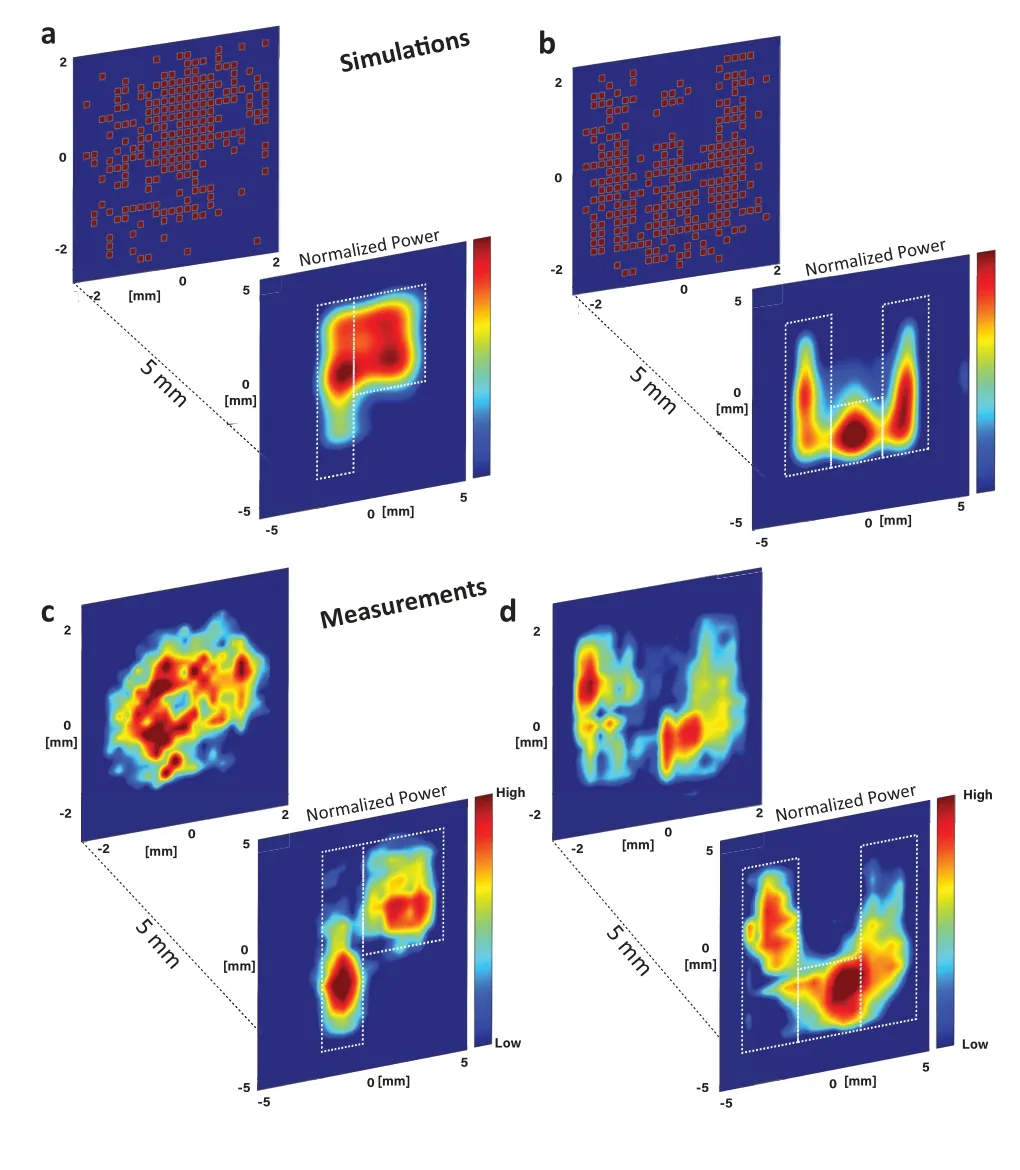
Figure 9.Simulated and measured far-field projection patterns at a distance of 5 mm.The switching conditions are optimized through a genetic algorithm for letters“P”and“U”[82].
The principle of operation is outlined in Figure 11[96].A frequency reconfigurable transmitter delivers a tunable or broadband signal through an on-chip leakywave antenna with frequency-dependent radiation patterns while the receiver also possesses a frequencydependent receiving pattern.Consequently,one can determine the angle of incidence simply by measuring and comparing received signal power across the spectrum.Two orthogonally placed chips can be used for practical 2D one-shot localization.The adoption of a spatial-varying frequency diverse pattern therefore greatly reduces the computational complexity of DOA estimation,at the price of radiating a wideband alignment spectrum intermittently.The measurement results including calibration map and localization results are shown in Figure 12.
The DOA estimation in the future is more likely to take advantage of the distinct features of the disjunctive communication frequency bands.A relatively low-frequency band with wider beamwidth is used for initial coarse alignment.After establishing an initial alignment,the communication can be switched to THz frequencies for more precise tracking and wideband data communication[97-99].
2.6 Secure Wireless Communications
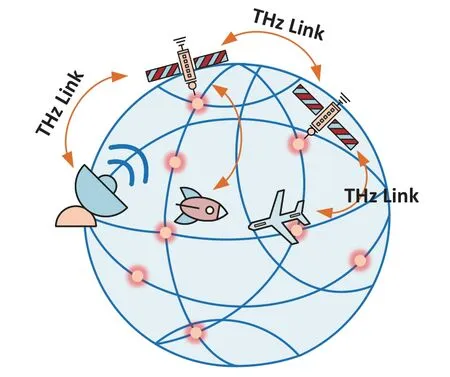
Figure 10.THz plays an important role in space and satellite communication,ranging from communication between satellites to communication involving airplanes,satellites,rockets,and base stations.
Due to its high directivity,lower-energy states,large bandwidth,and high vapor absorption,THz can be a perfect candidate for short-range secured communication to avoid potential eavesdropping.The implementation of phased arrays will provide higher security as compared to broadcasting by concentrating signal power towards the direction of interest.Nevertheless,since the sidelobes contain the same information as the main beam,an eavesdropper would listen to the sidelobes using a sensitive receiver to retrieve the identical information received at the targeted destination.Conventional solutions,such as encryption,rely on the exchange of security keys through a different channel.This can be problematic for two reasons.Firstly,the assumption that the exchange of security keys or security entities takes place in a safe channel can always be challenged.Secondly,encryption and decryption can impose non-negligible delay overhead in the critical data-path,such as during a remote surgery.Therefore,novel implementations of security across different layers in an Open Systems Interconnection(OSI)model are appreciated.The physical layer,the lowest layer in the OSI model,deserves additional attention.Once compromised,a physical layer vulnerability can invalidate all security measures implemented in the higher layers.Consequently,THz physical layer security is considered an indispensable candidate for implementing future wireless communication.The features of THz wavelengths,although posing challenges in long-distance transmission,can be exploited to enhance the security features for short-distance communication.Typically,two types of eavesdroppers are of our particular interests.Eavesdroppers can be located outside the targeted direction and try to collect information from sidelobe radiations and Non-Lineof-Sight(NLoS)signals,and they can also be located in between the transmitter and the receiver,for example,by placing a small scatterer in between the Lineof-Sight(LoS)path[100].Fundamentally,the implementations of THz physical layer security and secrecy rely upon the SNR differences between the targeted receiver,Bob,and the potential eavesdroppers,Eves,who can be located anywhere outside the secured region.Based upon Wyner’s wiretap model(Figure 13),the information stream is multiplied by two different channel matrices,one representing the channel between Alice and Bob,the other representing the channel between Alice and Eve.
If Alice transmits using an M-element arrayx(k),the signal received by a group of colluding eavesdroppers can be presented by:

wherenis the noise,His anNbyMmatrix,Nis the number of eavesdroppers,andMis the number of transmitting antenna elements.This relationship implies that mathematically,given enough number of colluding eavesdroppers and high enough SNR at the eavesdroppers,one can inverse the multiplication and estimate the transmitter excitationx′(k),hence the correct information going to the targeted direction can be estimated byHTx′(k),whereHTis the channel matrix between Alice and Bob.Such a representation suggests two ways of enhancing security:The first method is to introduce more noise at the eavesdroppers,such that the SNRs at the eavesdroppers reduce.As an example,artificial noise,like a cooperative jammer,can be introduced in a THz communication link to deteriorate the SNRs at the eavesdroppers in proximity[101].Directional modulation(DM)including Fourier-lens enabled DM[102],orthogonalvector DM[103],and near-field antenna perturbation DM[104],can be regarded as special realizations of the first method where the information at a different spatial angle is scrambled in the constellation and broadened in the spectrum.
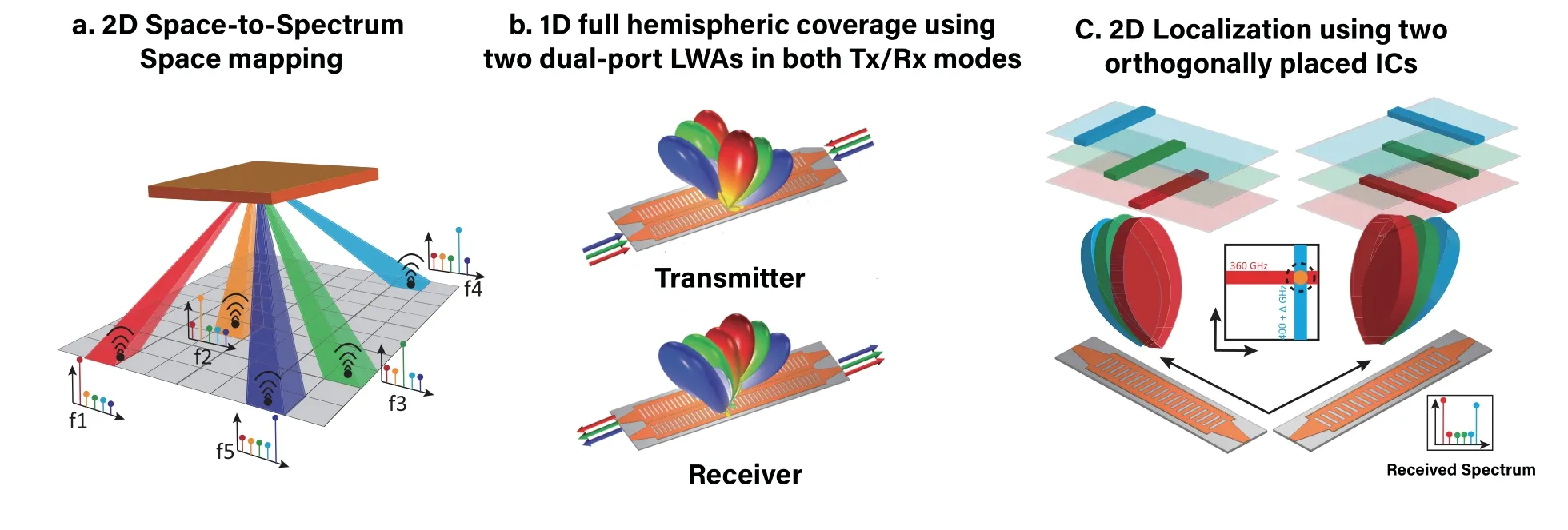
Figure 11.(a)The concept of 2-D space-to-spectrum mapping to allow one-shot localization.(b)A leaky-wave antenna is implemented both at the transmitter and receiver.(c)Two orthogonally placed ICs can be used for practical 2D one-shot localization[96].

Figure 12.(a)A cross-correlation technique is used to determine the frequency and thus the angle of incidence.(b)The measurement result of 1D angular localization shows an accurate estimation of incidence angle.(c)A 2D estimation is performed with orthogonally placed chips[96].
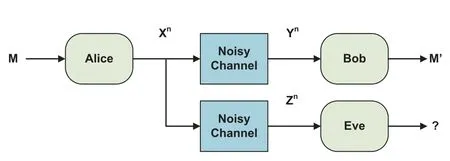
Figure 13.Wyner’s wiretap model.
In mmWave and THz transmission,the timemodulated array is one of the favorable directional modulation schemes[105,106].The circuit architecture of the sub-THz physical-layer secured directional communication chip is shown in Figure 14.In this work,the information is segmented and transmitted using different antenna elements,and the correct timedomain signal will be received only by the targeted receiver.At a different angle,a time domain mismatch introduces the generation of aliased frequency harmonics.The emerging of those harmonics not only introduces aliasing that forbids direct demodulation of the signal received at a different angle.The required bandwidth at the eavesdroppers also increases in order to capture the signal power distributed in the harmonics.Since the noise at the target receiver isKTBdata,while the noise at the eavesdroppers isKTBspreading,directional modulation introduces a significant SNR difference.As can be seen from the figure,the EVM over angle deteriorates as the angle increases from the targeted direction(broadside)at a rate much faster than that of a conventional phased array.This is further combined with the strong atmosphere absorption properties of THz waves.
The second catalog is to makeHEveill-conditioned.As an example,relays and/or multiple NLoS channels can be exploited to construct the channel matrices so that the transfer matrix between Alice and Bob is wellconditioned while the matrices between Alice and Eve are ill-conditioned and hard to be predicted[107-109].
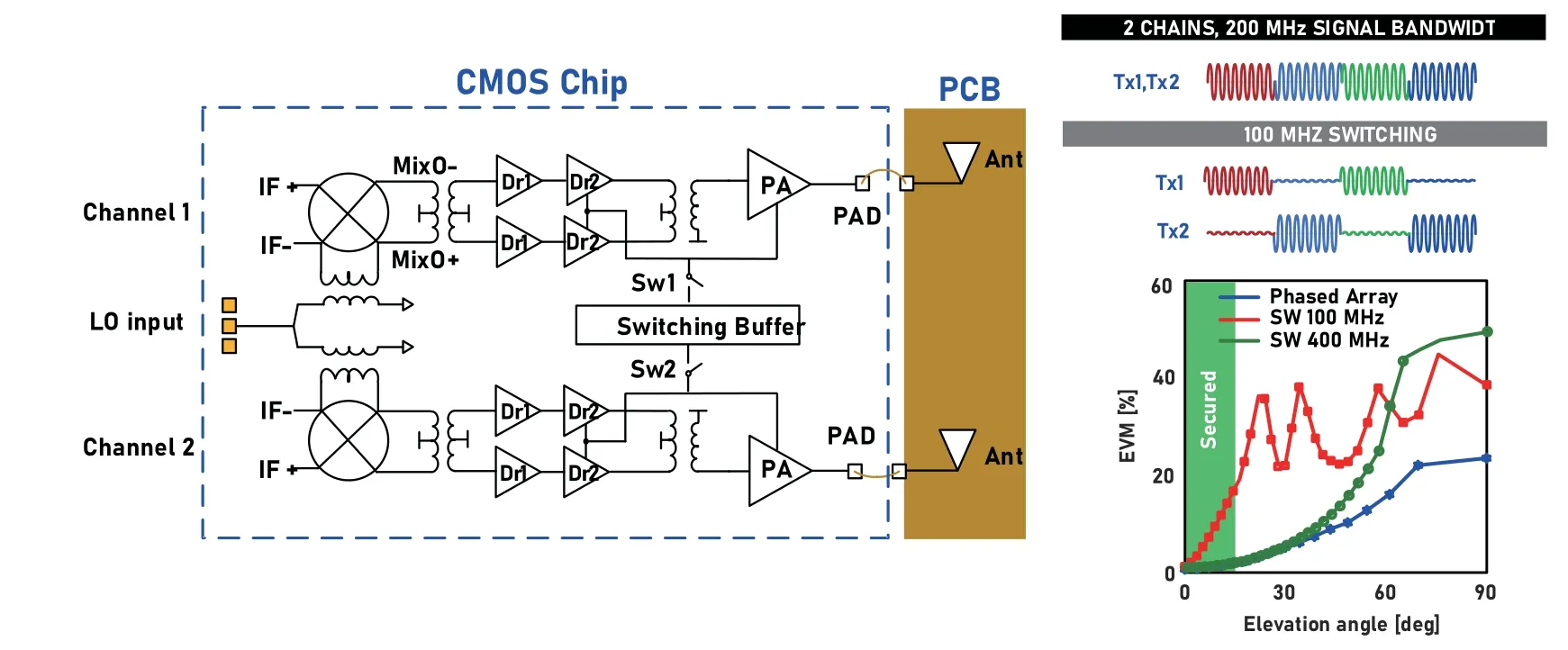
Figure 14.Circuit Architecture and EVM over angle for a sub-THz secured directional communication chip[105].
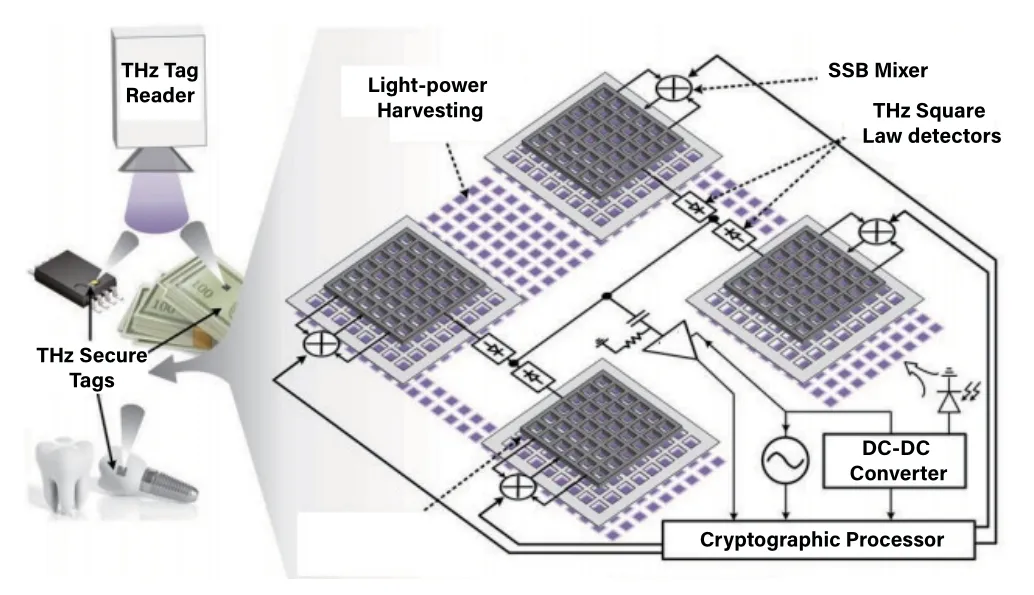
Figure 15.An intellectual reflective surface can be used to implement cryptography in NLOS channels[110].
Intuitively,a lens can focus power to a point in the 3D-space.Analogously,a spatially separated array of transmitters can construct the transfer matrix so that the power at the targeted destination is maximized,while pseudorandom signals are transmitted elsewhere.
In Figure 15[110],a cryptographic identification tag with backscattering and beam-steering is implemented at 260 GHz.The wireless information is encoded,altered,and processed on the fly through such an intelligent backscatter.While THz intelligent reflecting surfaces and backscatters have not been widely adopted for real-time data encryption,this work has proved the potential of integrated reflecting arrays.
The formerly mentioned methods take advantage of the narrow beamwidth and diffraction/reflection properties of THz.Other distinct features of THz waves,such as vapor absorption properties,can be leveraged as well[111].
III.INTEGRATED THZ IMAGING
THz imaging has been studied widely,ever since the first demonstration of THz imaging using a gas laser[112].The Abbe diffraction limit suggests that the minimum resolvable distance for a far-field THz sensing is

whereNAis the numerical aperture,andλis the wavelength.As compared to mmWave frequencies,THz can provide higher resolution due to its shorter wavelength.On the other hand,THz offers penetration through non-metallic materials such as plastic,foams,and papers that optical wavelengths cannot penetrate,which can be useful for security screening and nondestructive imaging of stratified substances such as oil-paintings.The strong absorption of THz by water and non-ionized radiation can also be exploited for safer medical imaging.Both coherent and noncoherent THz systems have been explored for imaging purposes.A detailed review of THz imaging has been carried out in[113].This section will focus on CMOS implementation of THz imaging.The biggest challenge in THz imaging is the data acquisition speed.In conventional THz broadband imaging systems,a mechanical raster scan is implemented for constructing a 2D image,which makes real-time applications,such as video-rate medical screening,infeasible.Both the transmitter and the receiver can be re-designed to overcome such a limitation.If a THz phased array can be used on the transmitter side,the radiated beam can be scanned electronically across a 2D space.The receiving mechanisms can be classified as non-coherent imaging,coherent imaging,and near-field imaging.
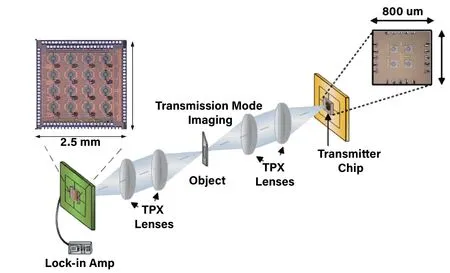
Figure 16.Integrated THz source and CMOS receiver at 280 GHz.The receiver consists of a 4×4 non-coherent detector array and occupies 2.5×2.5 mm2.TPx lenses are used for collimating THz beams and the object is placed on a translation stage for raster scanning[114].
3.1 Non-coherent THz Imaging
Similar to a CMOS camera,detector arrays can be implemented on the receiver side,as shown is shown in Figure 16[114].To construct non-coherent THz imaging,a THz detector such as Schottky barrier diodes(SBD)or customized field-effect transistors are implemented in integrated chips for THz detection.In an SBD,the THz signal will energize the electrons to overcome the barrier.The cutoff frequency of an SBD can be as high as 2 THz[115].While in a THz fieldtransistors,the THz wave modifies the plasma wave in the channel.Consequently,the THz signal can be detected through the change of voltage or current across the detecting transistors.For non-coherent THz imaging,the envelope of the incoming signal is extracted without the phase information.The electronic signal received by a non-coherent direct detector can be represented by

Direct detection methods provide the envelope of the signal but not the phase and frequency information.The Kramers-Kronig relationship can be exploited to extract phase information out of an amplitude waveform if the minimum phase condition is satisfied[116].Classical Kramers-Kronig receiver uses a strong single tone carrier so that the signal received by the direct detector becomes
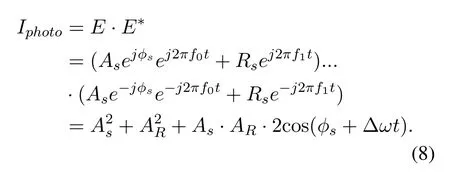
Thus,the phase information can be extracted from the third term,typically through digital signal processing.The synchronization between the signal and the source and the generation of strong IF power is omitted in a Kramers-Kronig(KK)receiver,so that the KK receiver consumes much less power as compared to intradyne and heterodyne receivers that are typically used for optical and RF signal receiving.The footprint of KK receivers is typically smaller as well since it only requires a single photodiode as compared to at least four photodiodes and two hybrids and the footprint of LO generation in the intradyne cases.However,The KK receivers require a strong single-tone carrier,which influences the overall system efficiency.A comprehensive study of the power efficiency of KK as compared to self-heterodyne and direct direction can be found in[117].The study suggests that the BER is related to the optical SNR by the following relation:

whereQ(x)=Mrepresents the modulation(M-QAM),andρrepresents the ratio between the specific bandwidth customarily used in the definition of the OSNR and the information-carrying signal bandwidth.
If the LO power is large enough,the KK receiver behaves similarly to an ideal coherent receiver.While in practical application,due to the presence of the relative intensity noise of local oscillators,typically a carrier-to-signal power ratio(CSPR)of 7 dB is used to ensure the minimum phase condition.New KK schemes to achieve a low CSPR ratio has been investigated[118,119].
The advantage of the direct detection method is that the circuitry,especially the pixel design,is simple and compact,yet still possesses relatively high sensitivity without cooling.FET-based THz sensors are usually narrowband designs optimized for the frequency of interest.A detailed review of THz detectors including non-integrable ones can be found in[120].The field of view and the resolution increases with the adoption of an array of detectors.Nevertheless,a raster scanner and lens setups are still necessary to image a large object.As shown in Figure 18,in a classical setup,A QCL laser is used to generate the THz signal,while the sample is placed on a motorized stage.A THz receiver array with 100 pixels is used to capture the transmissive THz signal,and a lock-in amplifier is implemented as part of the system for noise reduction.A tree leaf obscured behind a latex glove can be imaged with great details.However,there is still huge room for improvement to allow video-rate imaging using THz without mechanical scanning.
3.2 Coherent THz Detection
Non-coherent THz imaging provides amplitude only information or limited phase information at the price of strong carrier signal power.On the other hand,coherent detection with synchronized source and detector can offer orders of magnitude higher dynamic range by preserving the phase information.According to the observations and derivations in[121],the improvement of more than 42 dB can be achieved with the same focal plane array as compared to noncoherent imaging.While the early implementation of coherent THz detection is based upon a quasi-optically distributed LO signal[122],a fully electrically synchronized THz imaging system has been shown to form a reflection-type image for an object placed 5 meters away[123].Two challenges remain in the realization of active coherent imagers.The first challenge is the generation and distribution of LO power at THz,which thwarts the development of scalable coherent active imaging arrays.The second one is the scarcity of active amplifiers at THz frequency,which introduces a large NF at the receiver front-end.
The implementation of a fully coherent 2D array can be complicated.Luckily,spatial light modulation that is separate from the coherent detector can be an option that can benefit from both the high-resolution coherent detection offers and the spatial resolution direct detection has while avoiding mechanical raster scanning.Single-pixel THz imaging can be regarded as one of such implementations.A single-pixel THz imaging system can be built on top of a coherent THz imaging system by inserting a spatial light modulator in the light path.Typically those spatial light modulators are addressed either electrically or optically to display a programmable chess pattern.By assigning orthonormal chess patterns,compressive sensing algorithms can be implemented to greatly accelerate the image acquisition in comparison with raster scanning.In compressive sensing[124],a 2D estimation of the object from M measurements can be represented by:

whereP(x,y),mrepresents the chess patterns,andSmrepresents the strength difference between a pair of positive and negative patterns.
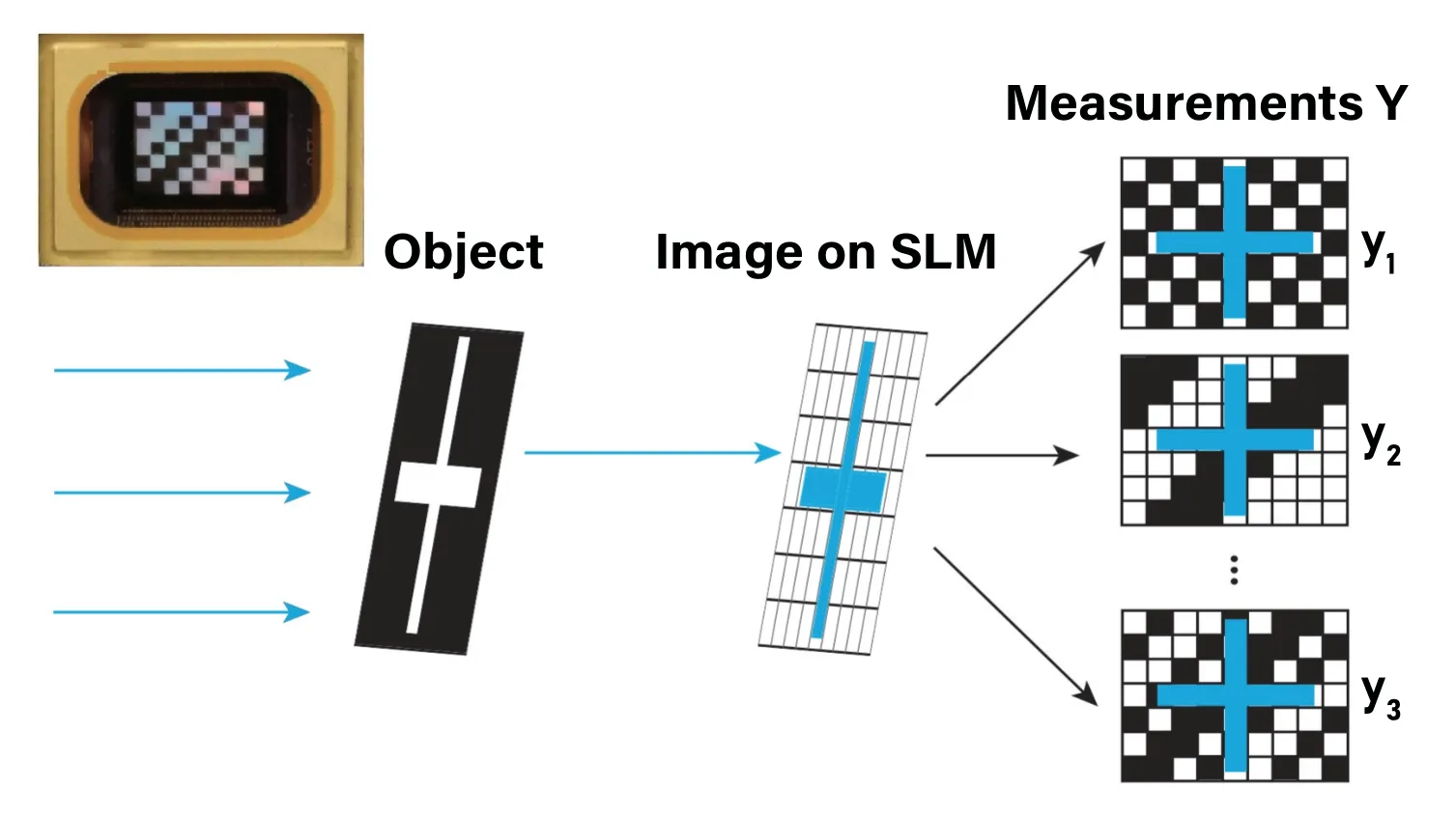
Figure 17.The concept of single-pixel THz imaging.A digital micro-mirror device is used to generate different patterns.THz wave intensity changes as the light modulator pattern changes,and a compressive sensing algorithm is used to construct the 2D image[124].
3.3 Near-field THz Imaging
Far-field THz imaging offers great accessibility in probing objects down to a 1 mm scale with a THz frequency of 300 GHz,especially for safe security screening.However,the resolution of far-field is insufficient in many non-destructive measurements,such as protein sensing,where higher resolution is preferred.As an example,THz imaging is adopted to investigate artwork and artifacts,especially oil-paintings with multiple layers and different pigments possessing distinctive polar modules that respond differently under THz radiation.Such a measurement will require both higher lateral and vertical resolution to approximately 50μm[126].Unlike far-field imaging that has limited resolution according to the Rayleigh Criterion,near-field imaging can break the diffraction limit by sensing the evanescent components of the THz wave,and the resolution is typically limited by the size of the tip.As suggested in[127],the polarizability of the probe tip is given by

whereRis the radius of the probe tip,∈tand∈sare the effective dielectric constant of the tip and the surface,respectively.The effective polarizability of the tip-surface interface is guided by

wherezis the distance of the tip to the surface.The scattering cross-section can be found as

whereλis the THz wavelength.Therefore,the resolution of a near-field THz probe is limited not by the diffraction limit,but by the size of the tip and the dielectric constant of the tip and the surface.The drawback of THz near-field imaging is its low efficiency for both scattering and absorption measurement,yet a 150 nm resolution can be achieved with a wavelength of 150μm[127].
IV.INTEGRATED THZ RADAR
4.1 Applications of THz Radar

Figure 18.THz direct detection imaging array working at 3.3 THz[125].(a)The measurement setup where a QCL source is used as the transmitter and a CMOS 100-pixel detector is used to receive the transmissive signals.(b)Images of a leave obscured behind latex,and photo and THz image of silicon chips fixed by scotch tapes.
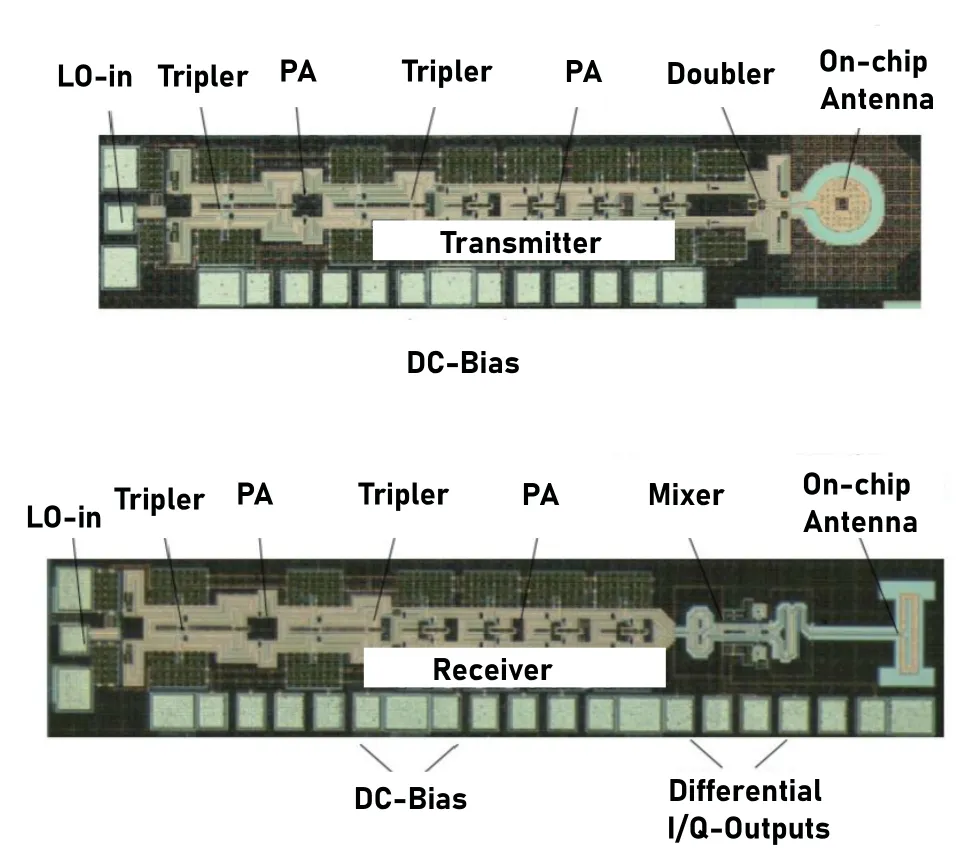
Figure 19.The chip photos of the THz FMCW radar Transceiver system at 0.32 THz[128].
THz frequency gains strong interest in security screening due to its ability to penetrate clothes,papers,and plastic packages.While booth-sized security screening devices are now widely implemented in airports,a light-weight THz screening system not only introduces a higher resolution in detecting concealed weapons and explosives but also adds flexibility to be integrated with drones or to be camouflaged for covert monitoring.Military application is another strong motivation for THz radar.An active THz radar system can function under many degraded visual environments(DVE),including in darkness,brownout,and foggy environments,and offer a good combination of resolution and penetration as compared to mmWave and Lidars.Furthermore,a THz radar offers good penetration depth into conventional cloaking materials to detect stealth aircraft[129].Furthermore,THz wavelength penetrates through face covers and masks while providing enough resolutions for facial recognition.Therefore,THz is considered one of the best candidates for fast and imperceptible security monitoring,and a rising star in future military applications.
4.2 The Principle of FMCW THz Radars
Frequency modulated continuous wave(FMCW)radar is one of the most popular implementations of integrated radar systems.Compared with pulsed radars,FMCW radar continuously delivers nearconstant power,and supports simultaneous transmitting and receiving.The FMCW prototypes have been implemented on CMOS with integrated frequency synthesizers and radiating elements.
In an FMCW radar,the transmitted signal is reflected by the target,and the received waveform is mixed with the transmitted signal to extract the frequency difference of two signals[130,131].Assume the transmitted signal is in the form of

whereμ=is the chirp rate defined by the bandwidthBand the sweep timeTp.The reflected signal at the receiver can be expressed as a time delayed version of the original waveform.

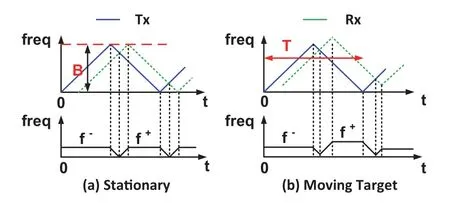
Figure 20.The operation principle of FMCW radar in detecting a stationary and a moving object.
whereτis defined asτ=R is the distance between the radar and the object,and c is the speed of light,respectively.After mixing,the beating signal after lowpass filtering can be expressed as

The beat frequency can be expressed as

and the distance of the object can be expressed as

where f+and f-represent the two offset frequencies,as shown in Figure 20.The speed can be estimated through the doppler shift of frequency as

The advantage of a THz FMCW radar over a mmWave one is its resolution.The resolution of an FMCW radar is given by

Given that a radar transceiver system supports a typical bandwidth of approximately 15% of the carrier,THz FMCW radar beyond 100 GHz offers enough resolution to identify concealed objects rather than giving a holistic,ballpark description as in a mmWave radar.A resolution of 6.8 mm is achieved using a 320 GHz FMCW using an operational bandwidth of 27 GHz that has a theoretical limit of 5.6 mm[132].
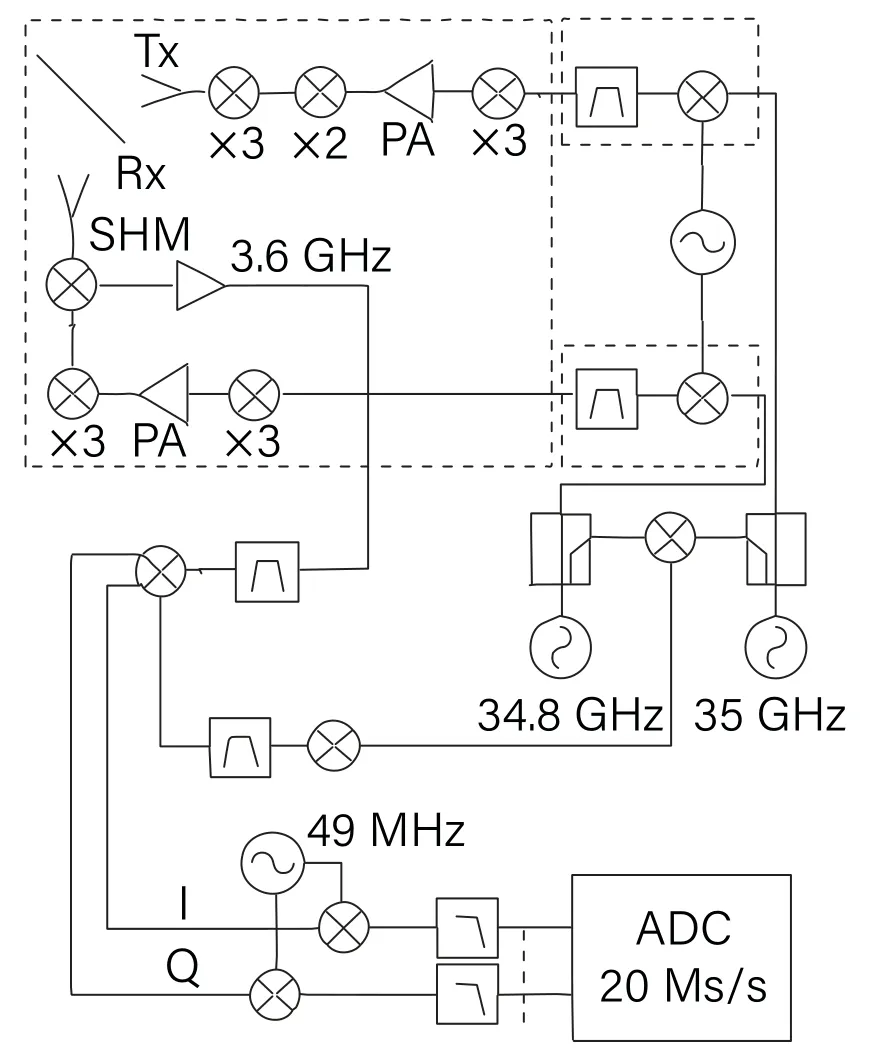
Figure 21.Circuit architecture of a THz FMCW radar in[133].
The architecture of an integrated THz FMCW radar is shown in Figure 21[133].The bottlenecks of implementing an integrated FMCW THz radar is to mitigate the effects of poor device performance at THz frequencies,which include and are not limited to 1)the large phase noise in the THz carrier signal,2)the nonlinearity of the chirp waveform,and 3)the poor noise figure of the receiving mixer at THz wavelength.In[133],chirp linearity compensation and phase noise cancellation methods are adopted to improve the performance of a THz radar.In order to minimize the effect of phase noise,the transmitter and the receiver need to be phase-locked.The range dependent noise can be represented by[134]:

whereLIFandLTx,are the phase noise at the receiver IF and at the transmitter,respectively,τthe delay time as defined previously.This equation suggests that short range phase noise is canceled by synchronizing the Tx and Rx.
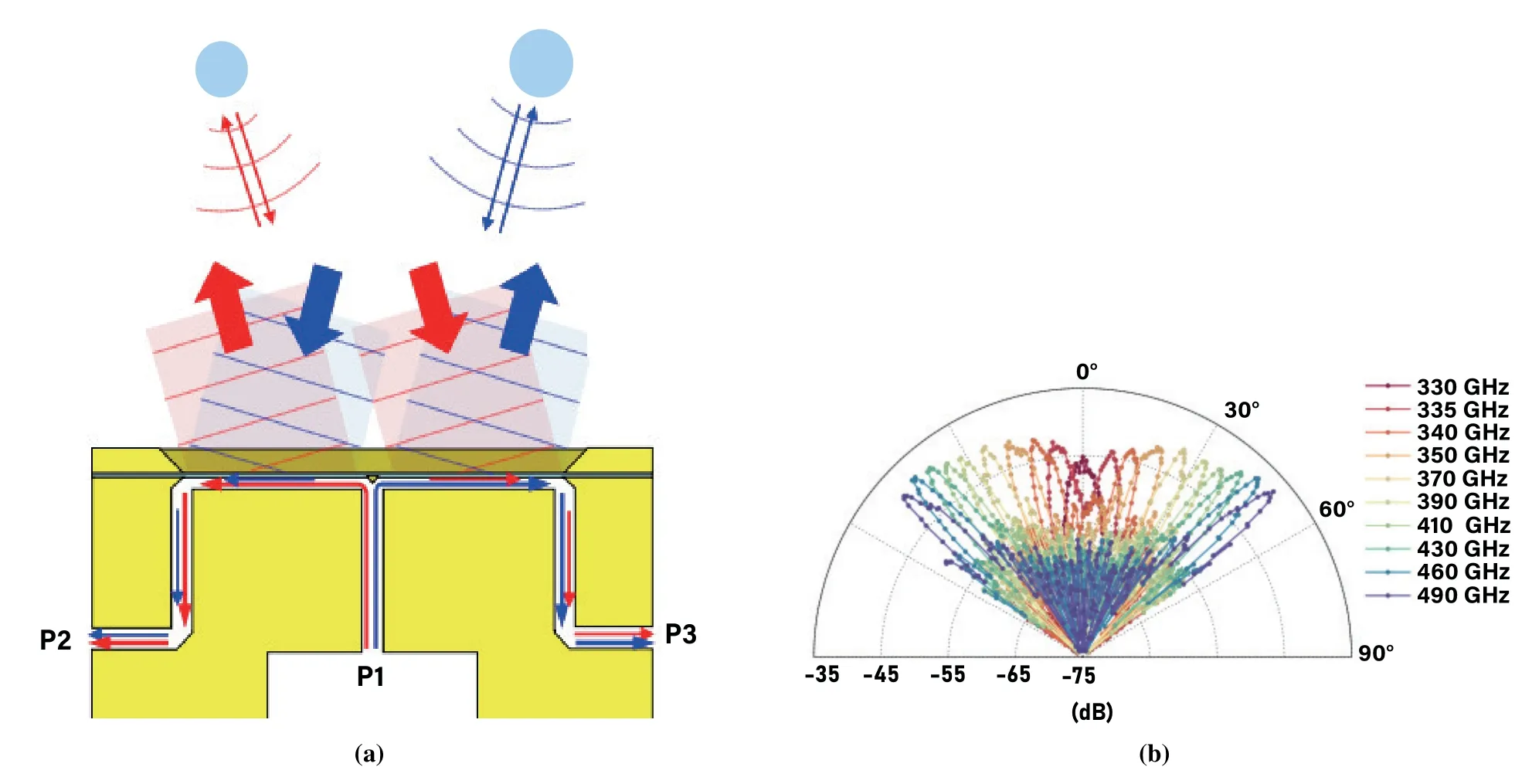
Figure 22.(a)In reverse-connected LWA,a TE10 mode splits into two and is radiated out into the air.The transmitted wave on the left-hand side of the T-split is reflected by the object on the right-hand side,and is mixed by a zero-biased Schottky barrier diode at the right port.(b)Frequency dependent radiation pattern of the LWA,similar to the LWA localization method introduced before[135].
4.3 Other Novel Realizations of THz Radars
In addition to the classical radar architecture mentioned above,novel antenna architectures can be utilized at THz frequency by taking advantage of the reduced antenna size at this wavelength.In[135],a reverse-connected leaky wave antenna is used for beam steering and homodyne detection in one antenna package,which circumvents the need for phase shifters,circulators,and lenses,as shown in Figure 22.
mmWave integrated radars are relatively welldeveloped and is now considered a critical component in future autonomous driving.The challenges of implementing powerful yet light-weight THz radar lies in both the strong atmosphere absorption of THz signals and the low efficiency in generating THz power,which results in a multi-dimensional tradeoff in aperture area,scan angle,range,and scan rate.Nevertheless,in scenarios with an abundance of energy,such as fixed devices on automobiles and in airports,the distinctive features of THz wavelengths can be effectively exploited.
V.INTEGRATED THZ SPECTROSCOPY
THz spectroscopy is adopted in various fields including agriculture,medicine,chemistry,astronomy,and meteorology.THz spectroscopy is favored for agricultural applications including water monitoring,pesticide monitoring,soil inspection,seed inspection,transgenics,and crop yield estimation[138].In medical applications,THz can be used for the detection of avidin-biotin binding[139]and DNA hybridization[140].THz is well studied to identify different gases,especially to allow rapid detection of isotopologues,to study liquid dynamics,and to identify the transformation between solid states.
Those applications often take advantage of the capability of THz radiations in exciting polar molecules with high sensitivity within the THz frequency band.Fundamentally,the signatures of polar molecules are produced due to periodically distributed transition lines that are directly related to the atomic weights.Typically,more than two transition lines shall be detected to assert the presence of certain polar molecules.Either the detector is dedicated for a specific purpose,such as vapor detection,or a large bandwidth is preferred for general-purpose spectrometry.

Figure 23.Two types of integrated spectrometers.(a)A continuous-wave spectrometer[136].(b)An integrated THz-TDs spectrometer[137].
In meteorology,THz spectroscopy is used to determine the concentration of vapor,oxygen,and ozone.The spectrum of oxygen has a distinctive transition line at 119 GHz and 425 GHz,while the vapor absorption line can be differentiated at approximately 183 GHz and 380 GHz[141,142].
Continuous-wave frequency spectroscopy and THz time-domain spectroscopy(THz-TDS)are the two widely-adopted methods.The majority of THz spectroscopy systems rely upon wideband THz-TDS for its bandwidth and the capability of extracting phase information.The time-domain signal is extracted and converted into frequency domain spectrum through Fourier transform,while the spectrum signal of the sample is then processed and compared with the spectrum signature of the substance to be identified.To improve the SNR,methods such as chopping,lock-in,and integration over time,are commonly used.Mathematical signatures,including linear models,second derivatives of the spectrum[143],debye relation models,and principle analysis,are among the most popular algorithms for data processing.
Bandwidth within which the signal has an SNR>1 is one of the most important figures of merit of spectroscopes.A commercially available non-integrated THZ-TDs system typically uses a femtosecond laser as a trigger and utilizes electro-optic materials,such as ZnTe or BBO crystals,as detectors.For instance,an Advantest TAS7500TS is capable of detecting impulses down to 380 fs with an SNR>1 bandwidth of more than 4 THz.In comparison,integrated spectroscopes based upon upconversion have been demonstrated,with comparable performance and a huge potential for improvement.
Integrated spectroscopes also fall into two catalogs:Time-domain spectroscopes that generate narrow pulses and frequency domain spectroscopes striving for increased bandwidth.In time-domain spectroscopes,the bandwidth is inversely proportional to the duration of the pulse byB=A picosecond duration corresponds to a THz order of bandwidth.Despite its wide bandwidth,THz-TDS systems suffer from a low signal power as the pulse becomes increasingly narrower.The duty cycle of the THz pulses is usually generated with a switching signal.To ensure a narrow pulse width,the challenge of a pulse-based integrated spectrometer essentially lies in the proper termination of high-order harmonics.Techniques including harmonic phase tuning[144],synchronized switching quality factor[137],and digital-to-impulse conversion[145]have been studied.The minimum pulse duration achieved is on the order of several picoseconds(As an example,4 ps corresponds to a bandwidth of 250 GHz,which is sufficient for measuring pesticide residues such as cis-permethrin[143]),which is limited by the transistor parasitic capacitance that deteriorates the switching speed of pulse generators,and by the low-Q passives on the chip[146].The other catalog,frequency domain spectrometry relies on tunable continuous-wave frequency synthesizers.Usually,high-Q passives are preferred for high-efficiency extraction of harmonic power,which inevitably limits its bandwidth.Generally,A 10% bandwidth can be obtained for frequency spectrometry.To overcome the frequency limitation,broadband frequency synthesis and detection methods have been proposed.A broadband frequency comb with a group of radiating elements,each covering a bandwidth of approximately 10 GHz,is implemented to extend the frequency coverage of a fully integrated system to 100 GHz.Broadband receiving scatterers with frequency-distinctive current distribution can be regarded as an alternative way to extract broadband frequency information[147].Distributed detectors are used to extract current distribution information over the surface,whereas the sensitivity of the system is limited by the noise captured at each of the detectors.
VI.CONCLUSION
In this review,we conducted a comprehensive study of integrated THz circuits and systems for different functionalities including communication,imaging,sensing,radar,and spectroscopy.The distinctive properties of THz waves are examined,including high directivity,high-frequency bandwidth,unique interaction with water,atmosphere,and molecules,and the ability to penetrate optically-opaque materials.
According to the prediction outlined in[148],the RF devices follow aPf2=constant line,while the development of commercial lasers follows aPλ=constant line.If the prediction holds,the microwave integrated circuits will outperform molecular lasers and QCLs for frequencies under approximately 2 THz.The biggest challenges yet to overcome,before practical applications of integrated mobile THz systems,are the low efficiency of THz power generation and the complexity of THz tuning mechanisms.The low efficiency of power generation can be partially overcome by spatial power combining over a group of coherent THz generators to reach a higher output power.Nevertheless,the heat dissipation related to low efficiency inevitably leads to a low energy density of THz generation,which applies to both MMICs and QCLs.Despite the challenges in generating THz sources,the detection of THz signals,especially noncoherent detection,is relatively easy.
One good news is,with the aid of edge and cloud computation,in many practical applications,the data rate for downlinks are much higher than that of the uplink,due to the fact that the human input rate is no more than Kbps,assuming the pattern of interaction with machines using mechanical movement such as mouse and keyboard persist in the next decade.This offers a great potential of THz communication in realizing wireless backhauls,fast kiosk downloading,and large bandwidth datalinks between satellites,while suppressing the side effect of THz communication by minimizing the power consumption of mobile devices.Communication is undoubtedly the most important aspect in future THz applications.Researchers are approaching a practical THz communication link from different aspects including channel measurement and modeling,improving the performance of THz sources,and optimizing system level designs.
In terms of imaging,radar,and sensing,with the prevalence of mmWave security screening kiosks in airports,we are confident that active THz imaging will sooner be widely implemented due to its superior resolution and smaller physical dimension.Medical applications of THz waves have been investigated,yet the development of a compact,hand-held THz device can greatly enhance the suitability of THz diagnosis in practical medical applications,which can be made possible with on-chip integration of antennas.
The unique properties of the THz spectrum will lead to irreplaceable applications in biochemistry,security,imaging,and communication.THz applications are still in their infancy and the realizations of those applications have not yet reached a mainstream convergence.Future research on integrated THz systems will be driven by multidisciplinary progress in electromagnetism,integrated circuits,material science,and biochemistry.
- China Communications的其它文章
- Towards 6G:Paradigm of Realistic Terahertz Channel Modeling
- Terahertz Wireless CommunicationS
- Channel Measurement and Path Loss Modeling from 220 GHz to 330 GHz for 6G Wireless Communications
- THz Channel Modeling:Consolidating the Road to THz Communications
- A 3-D Hybrid Dynamic Channel Model for Indoor THz Communications
- Wideband Channel Estimation for THz Massive MIMO

